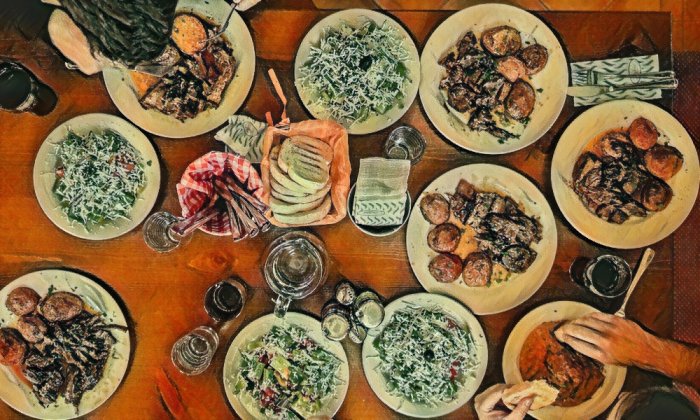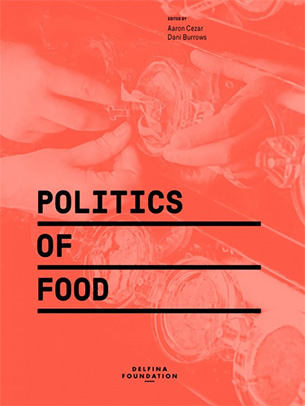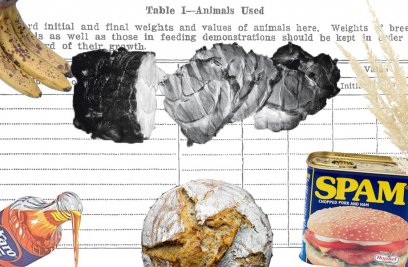We Are Who We Eat With: Food, Distinction, and Commensality

I recently stopped for a quick bite at a café on a short break between meetings. Despite being alone, I sat down with my food at a four-seat table — the only one free. Soon, a young woman, also alone, asked if she could share the table with me. “Sure,” I said, and she set down her tray. I heard her rummaging in her bag, but looked up again only when the flash of her smartphone camera went off three or four times. She smiled wryly, if slightly apologetically, and said “Snapchat,” before turning her attention back to her phone in order to transform her unremarkable plate of food into a tableau and to launch it into the ether.
Eating Together, Eating Alone
Since long before the dawn of humanity, eating has been a social act. Some of our primate ancestors shared food. Early humans were more successful when they banded together to hunt; they enjoyed greater security when they cooked and ate their food together.1 Farmers have long collaborated in a range of tasks, from chasing away the animals consuming their crops, to forming work parties in order to make some tasks possible and others easier or more pleasant.
I worked for many years in Mueda, a remote rural district in northern Mozambique. As I sat conducting ethnographic interviews in the yards outside the homes of peasant farmers, the daily activities of processing and preparing food went on all around. Young women peeled cassava and cut it into cubes, or removed kernels of maize from dried cobs. These staples were then placed into wooden mortars that reached mid-thigh-high, and were pounded with pestles nearly as tall as the women themselves. Rather than each of them working their own mortar, they would generally work one together. The laborious beat of a pestle, when integrated with another — sometimes two — produced a more energetic, often syncopated rhythm. At the top of each stroke, the women would release the pestle and clap hands, adding further percussive complexity. Playful competition emerged, as the women added additional claps, or increased the tempo until one of them missed a beat, and laughter gave them momentary pause from their work. When I asked them why they made the task more complicated, they generally told me that working together “animated” them, making the job easier despite the extra energy they put into it.

Many are the foods that bear evidence of the human inclination to share company in preparation and consumption. The geographical origins of dumplings are hotly debated among food historians. Variants are found all over the world. Traditional sizes, forms, and fillings vary from region to region, but they are generally a labor-intensive food. And in many places, this work has historically been done in groups — generally of women — sitting together, not only keeping one another company, but also passing on techniques, imitating and improving upon one another’s recipes and aesthetics. Men, too, share the work of preparing food. In south Texas, to give just one example, Chicano men stand together around the grill, barbecuing the off-cuts of meat that are central to their working-class cuisine; through playful banter equating meat with manhood, they reinforce group solidarity.2 To labor alone and, especially, to eat alone, is not only shameful in many cultural contexts, it is often considered monstrous or sub-human. In the villages of Mueda where I worked, there was a special word for one who ate alone: nkwaukanga. Such people were traditionally condemned as greedy, even ugly.
To labor alone and, especially, to eat alone, is not only shameful in many cultural contexts, it is often considered monstrous or sub-human.
But modern life has slowly changed this, and not only in Mueda. When I first moved from New York to London to take up a new post, colleagues often scolded me for my “American habit” of eating lunch at my desk in my office in order to minimize disruption from my work. They still took their “elevenses” and ate their lunch together in the staff common room — a practice that I gradually embraced even as it was disappearing. More and more, we eat alone, whether at work, at home, or even in restaurants. Indeed, eating together has become uncommon for many in a world defined by commuting and odd working hours, by fragmented families and by the ubiquity of convenience foods. Not only do office workers increasingly eat alone. The growing proportion of people whose work involves moving themselves, others, or things from one place to another generally “grab a bite” when and where they can. Children whose parents work at meal times increasingly eat pre-prepared meals, accompanied only by the television or a tablet. The elderly increasingly live on their own, and eat in isolation.
Such trends, however, have given rise to counter-trends. Expressions of nostalgia for the family meal are commonplace.3 It is not unusual these days to hear people boast about sitting together with family to eat — even if they struggle to do so. Meanwhile, hipsters have rediscovered the idea of commensality — coming together at the table — making of it a sort of retro fashion. Trendy coffee bars and restaurants seat people at shared tables to create a communal atmosphere and up-and-coming chefs organize pop-up diners in intimate spaces where sharing a meal with strangers adds to the excitement that makes their offering memorable and enhances their cachet. Even when people eat alone, they increasingly share their experience, like the Snapchatter I referred to above. Posting images of dishes on social media may seem like an act of self-absorption, prompting recipients to quip: “do you really think that I care what you are eating?”; or, “thanks for showing me what I’m not having!” But it connects people, at mealtime, to their broader social networks. It is an act of virtual commensality. And it bears evidence that the act of eating remains a profoundly social one, even in settings that make eating together difficult.
“We eat this . . .”
When I see people sharing images of their food on social media, I think of the words of the French gastronome Brillat-Savarin, who wrote in the early 18th century: “Tell me what you eat and I’ll tell you who you are.”4 Oh, how people do tell one another what they eat these days! But more fundamental to Brillat-Savarin’s aphorism is the idea that food serves as a distinctive marker of social identity. At the time he was writing, the diets of people around the world reflected profound connections to the particular natural environments in which they lived and to the cultural traditions into which they were born. Foodways were as distinctive as the dialects and accents with which people spoke. The cuisines — and thus people — of France could be divided, geographically, into areas mostly in the north that cooked with butter, those mostly in the center that used lard, and those in the south where olive oil was used5; styles of cheesemaking differentiated one market town and its catchment from its neighbor6; and so on. The peoples of the world could be similarly mapped by their foods. In East Africa, staples included millet and sorghum; in Asia, rice; in Mesoamerica, maize; and in the Andes, potatoes. There were a great many varieties of each of these cultivars, and the combinations grown and eaten in any one place — not to mention the methods by which they were prepared and the relishes that accompanied them — might have been read like a cultural fingerprint.
If “you are what you eat” — an inelegant paraphrasing of Brillat-Savarin — then those eating the same foods reproduce their individual bodies from the same substances and, together, create a shared social body. Those actually eating together perform their shared identity together, reinforcing bonds even more powerfully. Christ’s words, “take, eat, this is my body,” underlie the ritual through which Christians regularly reproduce the social body that is their congregation. Those who take the sacrament together become one body — the body of Christ. Eating from the same table — even the same plate or bowl — can express social solidarity, unity, and equality in subtle yet powerful ways. Families share food, but so do social clubs of myriad kinds. Eating together is a common means of team-building, from office parties to end-of-season sporting awards banquets.
The protagonists in Greek mythology are, time and again, fed by those they encounter during their journeys through strange lands.
The sharing of food is not limited to family and friends. Indeed, it may reach beyond the bounds of community to include strangers. In such contexts, rather than expressing or consolidating affinities, it may serve as a means to forge them — to suspend suspicion, to overcome difference and to level hierarchies. The earliest writings bear evidence of hospitality afforded to travelers. The protagonists in Greek mythology are, time and again, fed by those they encounter during their journeys through strange lands. In ancient times, travelers would often have been dependent upon their hosts for food, and hosts were often inclined to treat guests as they would have wished to be treated when traveling. The religions of the Levant all instruct the faithful to offer hospitality to visitors, including strangers.7 Jews are instructed to give food and clothing to the “sojourner” in Deuteronomy 10:18. Christians are told in Hebrews 13:2 that when they show hospitality to strangers, they may be entertaining angels unawares. And Muslims are told in Surah Al-Baqarah 177 that true righteousness lies, in part, in giving wealth to the traveler; this finds expression in Islamic cultures through, among other things, the provision of food to “wayfarers” and the needy. Around the world, the provision of food to others is often considered to be a marker of morality.
“. . . they eat that“
But sharing food is not as simple as it may appear. The heroes of Greek mythology frequently fall into jeopardy as their hosts take advantage of their state of dependence. Based upon ethnography in Madagascar, the anthropologist Maurice Bloch reminds us that, just as reproducing the family requires opening up to relationships with those beyond the family, eating entails opening the body to substances beyond it.8 The guest experiences both forms of vulnerability at the same time. Should trust in the host be misplaced, the guest may be poisoned. At the very least, they may be sent away hungry. In Mueda, people told me that when a host had had enough of a guest, they put enough chili in their food to make it inedible.
It is not only the guest for whom the sharing of food is fraught. My own arrival in Mueda, as a wayfaring anthropologist, bore evidence of this, and more generally of the ambivalent place of food in social relations. My Mozambican research partner and I arrived at his father’s village home well after everyone was asleep. They did not know we were coming, and had nothing specially prepared, so offered us leftovers from their simple evening meal: roasted snails. I ate them (as I had learned to do during a gap year spent in France), and in doing so — I was later told — signaled that I could be treated as family. But this, I learned, was precisely because they had expected me to decline. Other people of European origin who they had known — mostly Portuguese colonists — had not only refused to eat snails, they had cast the practice as disgusting, even primitive. “We alone eat snails,” they told me in reference to their Makonde ethnic group; “even our neighbors, the Makua, refuse.”
If the sharing of food expresses affinities, the other side of the coin is that food may serve as a language through which suspicions, differences, and enmities are communicated. If those who eat the same foods are part of the same social body, then those who do not are not. Prohibitions on the consumption of specific foods may serve as particularly powerful means of differentiating between social selves and social others. Some of the most notable food prohibitions have deep historical roots — Jewish and Muslim prohibitions on eating pork, the Hindu prohibition on eating beef. Original motives for such dietary laws are much debated9, but they have historically been intertwined with religious identity. At the same time, food prohibitions and dietary preferences may mark differences between ethnic groups (like Makonde and Makua), or between castes (like Brahmins and Dalits in the Indian context), or between social classes. The late French sociologist Pierre Bourdieu contrasted the food preferences of the French middle class and working class, arguing that food served as a means of creating social distinction.10 If sharing food may enact inclusion, eating separately or differently may cement exclusion.
If the sharing of food expresses affinities, the other side of the coin is that food may serve as a language through which suspicions, differences, and enmities are communicated.
Of course, some food avoidances are rooted in the body. Those with coeliac disease avoid gluten, while the lactose intolerant avoid dairy. Others may be rooted in worldview. Vegans may be motivated by concerns for animal welfare or biodiversity. In any case, the proliferation of dietary avoidances has created new eating communities with new sites of commensality, such as vegan cafes. It has also complicated longer-standing social eating practices. The French sociologist Claude Fischler has lamented that, where academic conference organizers cater to dietary preferences, the group no longer has a truly shared culinary experience, and no longer bonds at table as they once did.11
Even the sharing of food within tight-knit social groups may divide. I observed, in Mueda, that meat was parsed from the common plate in prescribed ways. The meat of the throat was normally given to the most respected elder in the group. Organ meats were also considered a delicacy and given to people of high social status. Women received less prestigious cuts and children received small bits of meat that had fallen off the bone. Young men watched as the meat was apportioned by an elder — sometimes quietly and sometimes with words that underlined the act — and they would eventually demonstrate their maturity by appropriately carving up meat that they brought home from the hunt. Through such practices, subtle hierarchies within the group — whether based on age, gender, or other kinds of social status — were enacted and reinforced, or challenged.
The Indian anthropologist Arjun Appadurai has depicted in detail how social status is rehearsed in the context of an Indian wedding feast. While rules apply (the family of the groom has higher status than the family of the bride; proximity through male kin ranks higher than proximity through female kin; etc.), there is much room for interpretation, especially when the common practice of cross-cousin marriage means that some guests fall into multiple social categories. How close one is seated to the bride and groom, how early one is served, etc., all signal where one stands with the hosts, leading to contentment or resentment.12
The use of food to perform social hierarchy within the family is not unfamiliar to Western contexts. Men working industrial jobs have often had first dibs on the meat at the dinner table. And with a few ethnographic revisions, Appadurai’s portrait of the politics of eating at the Indian wedding feast might describe weddings in many places. Social differentiation is also visibly manifest on a broader societal scale through market segmentation, as people of means buy their food at gourmet outlets such as Harrods’ food hall and Fortnum & Mason and dine at Michelin-starred restaurants, while those pinching pennies shop at discount supermarkets like Aldi and Lidl, and eat out at workmen’s cafes and fast food outlets. Such divisions may at times be bridged, as churches, community centers and social enterprises seek to provide food and places to eat to those in need through food banks, soup kitchens and holiday hunger programs. But where commensality is tenuous, so too is social solidarity, and charity can underscore the very disparities it seeks to address.
The New Global Menu
Notwithstanding the various forms of market segmentation and social differentiation discussed above, some would argue that globalization is, more broadly, standardizing diets around the world. Today, it would not be so easy for Brillat-Savarin to determine the nationality of a person by a description of what they eat. North Americans eat “Mexican food,” and Chicken Tikka Masala is the most popular dish in Britain. Australians eat “Asian fusion” foods, and the French eat Moroccan tagines. Indeed, all of these foods and many more can be found in cosmopolitan cities on every continent. And in nearly every part of the world, people eat McDonald’s hamburgers and Kentucky Fried Chicken. Further contributing to the homogenization of the global foodscape, the retail cold chain links consumers with producers from around the world year round, and processed food technology has given rise to a standard offer anywhere and everywhere.
But the globalization of food and foodways is an incomplete process. While canned soft drinks reach further than any other food or beverage, the reach of fast food chains and supermarkets is generally limited to cities and towns of some size. What is more, forces of standardization have met with opposing forces of diversification. Some point to the ways that cultures around the world have not only adopted, but also adapted global foodways, making even fast food chains like McDonald’s their own by bringing traditional eating practices into new spaces.13 Consumers of greater means sample world cuisine in “ethnic” restaurants — often staffed by migrants. Their culinary promiscuity gives rise to hybrid foodways — from dishes like the Balti (served in Indian restaurants, but said to originate in Birmingham), to Antipodean Cuisine — that constitute localized forms of the global.
What is more, alongside the “global food system,” a diverse array of “alternatives” have emerged and gathered momentum. In response to globalization, many have celebrated (re)localization, where possible consuming foods grown and made at close proximity. Where neoliberal trade has eroded culinary boundaries, advocates of food sovereignty have campaigned to restore national and even community autonomy in matters of food choice. The increasing market share of large-scale industrial agriculture has been met with rising consumer interest in organics and agroecology, and the ubiquity of processed foods has prompted a renaissance in artisan foods. The spread of fast food has been answered by some who celebrate Slow Food.
Just as food corporations stand to make considerable profits through opening new markets to their products, others — often, but not always, at a smaller scale — stand to benefit by the preservation or restoration of local foodways. Even in Europe, the value of culturally-distinctive foodways is significant enough that government — at local, regional, national, and even the EU level — has invested considerably in the protection of “designations of origin” that mandate self-governing groups of producers of traditional foods named for a specific place (such as Parmigiano-Reggiano cheese) to set geographical limitations on where foods by these names can be produced and the methods by which they can be made.14 Such foods and foodways have in many places been made central threads in regional development plans to attract visitors and to give foundation to sustainable livelihoods, whether in food making, in food retail, in catering and hospitality, or in cultural tourism.15 Of course, if the shipping of foods around the world leaves an enormous ecological footprint, so too does tourism, not only in the form of carbon emissions associated with travel but also in the form of strains on the environments in which distinctive local foods are grown and made. It remains to be seen whether the global population will sufficiently appreciate what is at stake as we move deeper into the Anthropocene, and whether we will find ways to mitigate the impact of our diets on the planet before it is too late.
Together at the Table
Despite the complex issues — some longstanding, others new — associated with food and foodways in our world today, food remains a potentially powerful means to connect people across divides. People’s first experiences of their social others often comes in the tasting of food, whether on holiday or in a restaurant on their very own high street. Whether wealthy expats or asylum seekers, migrants seek the familiar foods of home in new places, giving rise to new markets with novel items and “ethnic” restaurants that, at first, may provide migrants with an income and connect them to their own diaspora communities but, quickly, begin to connect them with their hosts and afford them standing in their new home.16
In a world where over half of the population now lives in cities, food often serves as a powerful vehicle to foster a sense of community. Urban community gardens are a fast-growing phenomenon. So too are community centers and social enterprises that organize cooking and nutrition classes. Street food has become popular in cities and towns around the world, and often constitutes a venue where people of diverse backgrounds and of mixed means may mingle as they eat.
While rural to urban migration leads to social isolation and loneliness in new places, it has often had similar effects in depopulated rural locales. Meal delivery, supper clubs, and memory cafes are increasingly found both in the city and in the countryside, as they afford means of (re)connecting people. In the UK, the Eden Project has pioneered The Big Lunch — a moveable feast put on by members of any community that wishes to participate. By their own account: “The Big Lunch is about millions of people getting together to share food, have fun and get to know each other better. It’s a simple idea — that for a few glorious hours, cars stop, shyness stops and neighbors come together in the street to meet, greet, share, swap, sing, plan and laugh.” Together with colleagues at the university where I teach and members of the community in mid-Devon in which I live, I organize the Crediton Living Library of Food Memories, which draws young and old together to share food-related memories; the project provides socialization for the aged, and helps inform youth about how food and foodways are changing so that they may make informed decisions in future, whether as consumers or as farmer and food makers.
Projects such as these afford opportunities for us to reflect on the profound relationship between food and society. Every time we eat, we craft our identities, perform relationships, and shape our communities, from the local to the global. Eating therefore warrants contemplation and care, and should be a locus of creative — sometimes disruptive — activity as exemplified by the contributors to this volume.
Harry G. West is a socio-cultural anthropologist specializing in political anthropology and the anthropology of food, farming, and agrarian society. He is Professor of Anthropology and Convener of the MA in Food Studies, University of Exeter. This article excerpted from the volume “Politics of Food” (Sternberg Press)
References:
- M. Jones, Feast: Why Humans Share Food, Oxford: Oxford University Press, 2007.
- J. E. Limón, Dancing with the Devil: Society and Cultural Poetics in Mexican-American South Texas, Wisconsin: University of Wisconsin Press, 1994.
- A. Murcott (ed.), ‘Family Meals – A Thing of the Past?’, in P. Caplan, Food, Health and Identity, London: Routledge, 2013, pp. 32–49.
- J. A. Brillat-Savarin, The Physiology of Taste [1825], London: Penguin Classics, 1970.
- W. Root, The Food of France, London: MacMillan, 1958.
- H. G. West, ‘Je m’appelle . . . Cheese’, in Food, Culture and Society, vol. 15, no. 1, 2012, pp. 8–12.
- M. Siddiqui, Hospitality and Islam: Welcoming in God’s Name, New Haven and London: Yale University Press, 2015.
- M. Bloch, ‘Commensality and Poisoning’, in Social Research, vol. 66, no. 1, 1999, pp. 133–149.
- M. Douglas, ‘The abominations of Leviticus’, in Purity and Danger, London,: Routledge, 1991 (1966), pp. 42–58; M. Harris, ‘The abominable pig’, in Good to Eat: Riddles of Food and Culture, Long Grove, IL.: Waveland Press, 1998 (1985), pp. 67–88.
- P. Bourdieu, Distinction, Cambridge, MA: Harvard University Press, 1984.
- C. Fischler, Selective Eating: The Rise, Meaning and Sense of Personal Dietary Requirements, Paris: Odile Jacob, 2015.
- A. Appadurai, ‘Gastro-Politics in Hindu South Asia’, in American Ethnologist, vol. 8, no. 3, 1981, pp. 494–511.
- J. L. Watson, ed., Golden Arches East: McDonald’s in East Asia, Stanford, CA: Stanford University Press, 1997.
- H. G. West, ‘Appellations and Indications of Origin, Terroir, and the Social Construction and Contestation of Place-Named Foods’, in W. Belasco, P. Jackson and A. Murcott (eds.), The Handbook of Food Research, London: Bloomsbury, 2013, pp. 209–228.
- H. G. West, ‘Artisanal Foods and the Cultural Economy: Perspectives on Craft, Heritage, Authenticity and Reconnection’, in J. Klein and J. L. Watson (eds.), The Handbook of Food and Anthropology, London: Bloomsbury, 2016, pp. 406–434.
- E. J. Abbots, ‘Approaches to Food and Migration: Rootedness, Being and Belonging’, in J. Klein and J. L. Watson (eds.), The Handbook of Food and Anthropology, London: Bloomsbury, 2016, pp. 115–132.




